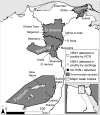Putative human and avian risk factors for avian influenza virus infections in backyard poultry in Egypt
- PMID: 24315038
- PMCID: PMC3890107
- DOI: 10.1016/j.vetmic.2013.11.010
Putative human and avian risk factors for avian influenza virus infections in backyard poultry in Egypt
Abstract
Highly pathogenic influenza A virus subtype H5N1 causes significant poultry mortality in the six countries where it is endemic and can also infect humans. Egypt has reported the third highest number of poultry outbreaks (n=1084) globally. The objective of this cross-sectional study was to identify putative risk factors for H5N1 infections in backyard poultry in 16 villages in Damietta, El Gharbia, Fayoum, and Menofia governorates from 2010-2012. Cloacal and tracheal swabs and serum samples from domestic (n=1242) and wild birds (n=807) were tested for H5N1 via RT-PCR and hemagglutination inhibition, respectively. We measured poultry rearing practices with questionnaires (n=306 households) and contact rates among domestic and wild bird species with scan sampling. Domestic birds (chickens, ducks, and geese, n=51) in three governorates tested positive for H5N1 by PCR or serology. A regression model identified a significant correlation between H5N1 in poultry and the practice of disposing of dead poultry and poultry feces in the garbage (F=15.7, p<0.0001). In addition, contact between domestic and wild birds was more frequent in villages where we detected H5N1 in backyard flocks (F=29.5, p<0.0001).
Keywords: Disease reservoirs; Influenza A virus – H5N1 subtype; Influenza in birds; Poultry diseases; Zoonoses.
Copyright © 2013 Elsevier B.V. All rights reserved.
Conflict of interest statement
The authors have no conflict of interest to declare.
Figures
Similar articles
-
Surveillance on A/H5N1 virus in domestic poultry and wild birds in Egypt.Virol J. 2013 Jun 22;10:203. doi: 10.1186/1743-422X-10-203. Virol J. 2013. PMID: 23799999 Free PMC article.
-
Highly pathogenic avian influenza (H5N1) in ducks and in-contact chickens in backyard and smallholder commercial duck farms in Viet Nam.Prev Vet Med. 2011 Sep 1;101(3-4):229-40. doi: 10.1016/j.prevetmed.2010.05.016. Epub 2010 Jul 1. Prev Vet Med. 2011. PMID: 20594603
-
Avian influenza surveillance reveals presence of low pathogenic avian influenza viruses in poultry during 2009-2011 in the West Bengal State, India.Virol J. 2012 Aug 7;9:151. doi: 10.1186/1743-422X-9-151. Virol J. 2012. PMID: 22867041 Free PMC article.
-
Origin and evolution of highly pathogenic H5N1 avian influenza in Asia.Vet Rec. 2005 Aug 6;157(6):159-64. doi: 10.1136/vr.157.6.159. Vet Rec. 2005. PMID: 16085721 Review.
-
Highly pathogenic avian influenza H5N1, Thailand, 2004.Emerg Infect Dis. 2005 Nov;11(11):1664-72. doi: 10.3201/eid1111.050608. Emerg Infect Dis. 2005. PMID: 16318716 Free PMC article. Review.
Cited by
-
Garbage Management: An Important Risk Factor for HPAI-Virus Infection in Commercial Poultry Flocks.Front Vet Sci. 2018 Jan 26;5:5. doi: 10.3389/fvets.2018.00005. eCollection 2018. Front Vet Sci. 2018. PMID: 29435454 Free PMC article.
-
Molecular pathogenic and host range determinants of reassortant Egyptian low pathogenic avian influenza H9N2 viruses from backyard chicken.Int J Vet Sci Med. 2019 Jul 11;7(1):10-19. doi: 10.1080/23144599.2019.1637046. eCollection 2019. Int J Vet Sci Med. 2019. PMID: 31620483 Free PMC article.
-
Avian influenza A (H5N1) outbreaks in different poultry farm types in Egypt: the effect of vaccination, closing status and farm size.BMC Vet Res. 2018 Jun 18;14(1):187. doi: 10.1186/s12917-018-1519-8. BMC Vet Res. 2018. PMID: 29914481 Free PMC article.
-
Assessment of poultry rearing practices and risk factors of H5N1 and H9N2 virus circulating among backyard chickens and ducks in rural communities.PLoS One. 2022 Oct 11;17(10):e0275852. doi: 10.1371/journal.pone.0275852. eCollection 2022. PLoS One. 2022. PMID: 36219598 Free PMC article.
-
Spatio-temporal dynamics and risk cluster analysis of highly pathogenic avian influenza (H5N1) in poultry: Advancing outbreak management through customized regional strategies in Egypt.Open Vet J. 2024 Nov;14(11):2911-2923. doi: 10.5455/OVJ.2024.v14.i11.20. Epub 2024 Nov 30. Open Vet J. 2024. PMID: 39737019 Free PMC article.
References
-
- Aly FA, Oueda MA, Helal HA, Madian AAM. Study of avian flu preventive practices among home poultry breeders in rural Egypt. World Applied Sciences Journal. 2012;17:1009–1019.
-
- Egyptian Environmental Affairs Agency. National Solid Waste Report of the Arab Republic of Egypt Prepared by the Regional Network for the Transfer and Exchange of Experiences between the Countries of the East and the West. Ministry of State for Environmental Affairs; Cairo: 2011. http://www.eeaa.gov.eg/arabic/reports/env_waste/ANNEX1~1.pdf.
-
- El-Gendy AB. Egypt Statistical Yearbook. Vol. 102. Central Agency for Public Mobilization and Statistics, Arab Repblic of Egypt; Cairo: 2011.
-
- El-Messery MA, Ismail GA, Arafa AK. Evaluation of municipal solid waste management in Egyptian rural areas. Journal of the Egyptian Public Health Association. 2009;84:52–71. - PubMed
Publication types
MeSH terms
Grants and funding
LinkOut - more resources
Full Text Sources
Other Literature Sources
Medical


